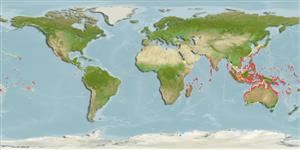Common names from other countries
>
Gobiiformes (Gobies) >
Gobiidae (Gobies) > Gobiinae
Etymology: Fusigobius: Latin, fusus = spindle + Latin, gobius = gudgeon (Ref. 45335); humeralis: Named for the black spot in the humeral region, the most distinct marking..
More on author: Randall.
Environment: milieu / climate zone / depth range / distribution range
Sinh thái học
Biển gần đáy; Mức độ sâu 3 - 30 m (Ref. 54980). Tropical
Indo-Pacific: Red Sea to French Polynesia, north to the Ryukyu Islands, south to the Great Barrier Reef and New Caledonia.
Bộ gần gũi / Khối lượng (Trọng lượng) / Age
Maturity: Lm ? range ? - ? cm
Max length : 4.4 cm SL con đực/không giới tính; (Ref. 54980); 3.2 cm SL (female)
Short description
Khóa để định loại | Hình thái học | Sinh trắc học
Các tia vây lưng cứng (tổng cộng) : 7; Các vây lưng mềm (tổng cộng) : 9; Tia cứng vây hậu môn: 1; Tia mềm vây hậu môn: 8; Động vật có xương sống: 26. Diagnosis: Dorsal rays VI - I,9. Anal rays 1,8. Pectoral rays 17-19 (usually 18). Longitudinal scale series 25. Head naked except for scales on side of nape reaching nearly to orbit. Posterior nostril near edge of orbit. Body depth 4.4-4.8 in SL; snout short, 3.4 - 3.7 in head. First dorsal fin not higher than second (longest dorsal soft ray longer than longest dorsal spine); second or third dorsal spines longest, 5.35-5.8 in SL. Pelvic fins fully joined medially by membrane (when intact); pelvic frenum present. Body translucent with numerous small dusky orange-yellow spots on head and body, those on head in oblique rows; a round black spot as large or larger than pupil in humeral region just above base of pectoral fin, and a second black spot of about the same size at mid base of caudal fin (Ref. 41649).
Inhabits sand-rubble bottoms next to reefs in 3-30 m (Ref. 90102).
Life cycle and mating behavior
Maturities | Sự tái sinh sản | Spawnings | Egg(s) | Fecundities | Ấu trùng
Randall, J.E., 2001. Five new Indo-Pacific gobiid fishes of the genus Coryphopterus. Zool. Stud. 40(3):206-225. (Ref. 41649)
IUCN Red List Status (Ref. 130435)
CITES (Ref. 128078)
Not Evaluated
Threat to humans
Harmless
Human uses
Các công cụ
Special reports
Download XML
Các nguồn internet
Estimates based on models
Preferred temperature (Ref.
115969): 24.7 - 29.3, mean 28.3 (based on 2802 cells).
Phylogenetic diversity index (Ref.
82804): PD
50 = 0.5005 [Uniqueness, from 0.5 = low to 2.0 = high].
Bayesian length-weight: a=0.01023 (0.00477 - 0.02194), b=3.02 (2.84 - 3.20), in cm Total Length, based on LWR estimates for this (Sub)family-body shape (Ref.
93245).
Mức dinh dưỡng (Ref.
69278): 3.2 ±0.3 se; based on size and trophs of closest relatives
Thích nghi nhanh (Ref.
120179): Chiêù cao, thời gian nhân đôi của chủng quần tối thiểu là dưới 15 tháng (Preliminary K or Fecundity.).
Fishing Vulnerability (Ref.
59153): Low vulnerability (10 of 100).
